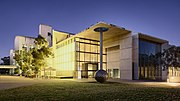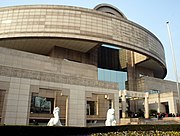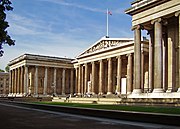Portal:Museums: Difference between revisions
| Line 100: | Line 100: | ||
| File:Museum of vodka.jpg | A museum in Verkhniye Mandrogi, [[Leningrad Oblast]], specialising in [[vodka]] |
| File:Museum of vodka.jpg | A museum in Verkhniye Mandrogi, [[Leningrad Oblast]], specialising in [[vodka]] |
||
| File:15 23 0224 USHMM.jpg | The Tower of Faces at the [[United States Holocaust Memorial Museum]], Washington, D.C. |
| File:15 23 0224 USHMM.jpg | The Tower of Faces at the [[United States Holocaust Memorial Museum]], Washington, D.C. |
||
| File:National Gallery of Victoria Great Hall 2017.jpg | The Great Hall of the [[National Gallery of Victoria]], Australia, has the world's largest [[stained-glass]] ceiling, designed by [[Leonard French]]. |
|||
| File:Storage Gallery.jpg | Storage gallery of the [[Larco Museum]], [[Lima]], Peru, a museum of [[pre-Columbian]] art |
|||
| File:ساحة المتحف المصري.jpg | The [[Egyptian Museum]], [[Cairo]], showing some of its collection of [[ancient Egypt]]ian antiquities |
|||
}} |
}} |
||
{{Box-footer}} |
{{Box-footer}} |
||
| Line 151: | Line 154: | ||
| File:Brama Arbeit Macht frei.jpg | Entrance to [[Auschwitz|Auschwitz I]], part of the [[Auschwitz-Birkenau Memorial and Museum]], a [[Holocaust]] museum on the site of the former [[Nazi concentration camps]] |
| File:Brama Arbeit Macht frei.jpg | Entrance to [[Auschwitz|Auschwitz I]], part of the [[Auschwitz-Birkenau Memorial and Museum]], a [[Holocaust]] museum on the site of the former [[Nazi concentration camps]] |
||
| File:Israel-2013(2)-Aerial-Jerusalem-Yad Vashem 01.jpg | Aerial view of [[Yad Vashem]], Jerusalem, Israel's [[Holocaust]] memorial; the museum, designed by [[Moshe Safdie]], opened in 2005 and tells the personal stories of ninety Holocaust victims and survivors |
| File:Israel-2013(2)-Aerial-Jerusalem-Yad Vashem 01.jpg | Aerial view of [[Yad Vashem]], Jerusalem, Israel's [[Holocaust]] memorial; the museum, designed by [[Moshe Safdie]], opened in 2005 and tells the personal stories of ninety Holocaust victims and survivors |
||
| File:Air space exhibits 01.jpg | |
| File:Air space exhibits 01.jpg | Now closed, the [[California Science Center|California Aerospace Museum]], designed by [[Frank Gehry]], formerly displayed a [[Lockheed F-104 Starfighter]] |
||
| File:National Palace Museum Front View.jpg | [[Paifang]] or arched entrance of the Northern Branch of the [[National Palace Museum]], Taiwan, whose collection covers 8,000 years of the history of [[Chinese art]] |
|||
| File:National Art Center Tokyo 2008.jpg | The [[The National Art Center, Tokyo|National Art Center]], Tokyo, designed by [[Kisho Kurokawa]], is an "empty museum", lacking its own collection, which hosts temporary exhibitions from other organisations. |
|||
| File:Shanghai Museum exterior 5.jpg | [[Shanghai Museum]], a museum of ancient [[Chinese art]], was rebuilt in 1996 to a design inspired by the ''[[ding (vessel)|ding]]'', an ancient bronze cooking vessel. |
|||
| File:National Gallery at dusk, Canberra ACT.jpg | The [[National Gallery of Australia]], [[Canberra]] |
|||
| File:Figueres 28.jpg | The [[Dalí Theatre and Museum]], commemorating [[Salvador Dalí]] in his home town of [[Figueres]], [[Catalonia]], has a geodesic dome and is decorated with giant eggs. |
|||
| File:Matenadaran, Ereván, Armenia, 2016-10-03, DD 22.jpg | The [[Matenadaran]], [[Yerevan]], Armenia, has an extensive collection of [[Armenian language|Armenian]] manuscripts. |
|||
| File:Bellas Artes 01.jpg | The [[Palacio de Bellas Artes]], [[Mexico City]], has a permanent collection of murals and hosts an [[architecture museum]]. |
|||
| File:Bilbao - Guggenheim aurore.jpg | The [[Guggenheim Museum Bilbao]], Spain, a modern [[art museum]] designed by [[Frank Gehry]] and completed in 1997 |
|||
}} |
}} |
||
{{Box-footer}} |
{{Box-footer}} |
||
Revision as of 04:24, 9 May 2019
| This portal is being considered for deletion in accordance with Wikipedia's deletion policy.
Please discuss the matter at this page's entry on the Miscellany for deletion page. You are welcome to edit this page, but please do not blank, merge, or move it, or remove this notice, while the discussion is in progress. For more information, see the Guide to deletion. |
A museum is an institution dedicated to displaying and/or preserving culturally or scientifically significant objects. Many museums have exhibitions of these objects on public display, and some have private collections that are used by researchers and specialists. Museums host a much wider range of objects than a library, and usually focus on a specific theme, such as the arts, science, natural history or local history. Public museums that host exhibitions and interactive demonstrations are often tourist attractions, and many attract large numbers of visitors from outside their host country, with the most visited museums in the world attracting millions of visitors annually.
Since the establishment of the earliest known museum in ancient times, museums have been associated with academia and the preservation of rare items. Museums originated as private collections of interesting items, and not until much later did the emphasis on educating the public take root. (Full article...)
The Croatian Natural History Museum (Croatian: Hrvatski prirodoslovni muzej) is the oldest and biggest natural history museum and the main body for natural history research, preservation and collection in Croatia. Located on Dimitrije Demeter Street in Gornji Grad, one of the oldest neighbourhoods of the Croatian capital Zagreb, it owns one of the biggest museum collections in Croatia, with over 2 million artefacts, including over 1.1 million animal specimens. It was founded in 1846 as the "National Museum". The National Museum was later split up into five museums, three of which were in 1986 merged as departments of the newly named Croatian Natural History Museum. The museum contains a large scientific library open to the public, and publishes the first Croatian natural history scientific journal, Natura Croatica.
The permanent display of the Croatian Natural History Museum consists of mineralogical, petrographical and zoological collections, as well as two permanent exhibits in the atrium: the Rock Map of Croatia and the Geological Pole. It is home to the remains of the Neanderthal from Krapina. As of 2021, the museum is closed pending the completion of reconstruction following the 2020 Zagreb earthquake. (Full article...)

Heritage science is the interdisciplinary domain of scientific study of cultural and natural heritage. Heritage science draws on diverse humanities, sciences and engineering disciplines. It focuses on enhancing the understanding, care and sustainable use of heritage so it can enrich people's lives, both today and in the future. Heritage science is an umbrella term encompassing all forms of scientific enquiry into human works and the combined works of nature and humans, of value to people.
The above definition was developed though a community consultation organised by ICCROM and the European Research Infrastructure for Heritage Science in 2019. (Full article...)
- ... that the Deutsches Romantik-Museum in Frankfurt, the only museum dedicated to the entire era of German Romanticism, looks like three houses and features blue elements?
- ... that Kobe and Vanessa Bryant were founding donors of the National Museum of African American History and Culture?
- ... that landscape architect Harriet Pattison collaborated with her lover Louis Kahn on the design of Four Freedoms Park and the grounds of the Kimbell Art Museum?
- ... that the site of the headquarters of the German colonization of Texas was converted into a museum?
- ... that exhibits at Peale's Philadelphia Museum included the first nearly complete skeleton of a mastodon?
- ... that the Republican Palace Museum in Khartoum was originally a cathedral?
For editor resources and to collaborate with other editors on improving Wikipedia's Museums-related articles, see WikiProject Museums.

A virtual museum is a digital entity that draws on the characteristics of a museum, in order to complement, enhance, or augment the museum experience through personalization, interactivity, and richness of content. Virtual museums can perform as the digital footprint of a physical museum, or can act independently, while maintaining the authoritative status as bestowed by the International Council of Museums (ICOM) in its definition of a museum. In tandem with the ICOM mission of a physical museum, the virtual museum is also committed to public access; to both the knowledge systems embedded in the collections and the systematic, and coherent organization of their display, as well as to their long-term preservation. As with a traditional museum, a virtual museum can be designed around specific objects (such as an art museum or a natural history museum), or can consist of online exhibitions created from primary or secondary resources (as, for example in a science museum). Moreover, a virtual museum can refer to the mobile or World Wide Web offerings of traditional museums (e.g., displaying digital representations of its collections or exhibits); or can be born digital content such as, 3D environments, net art, virtual reality and digital art. Often, discussed in conjunction with other cultural institutions, a museum by definition, is essentially separate from its sister institutions such as a library or an archive. Virtual museums are usually, but not exclusively delivered electronically when they are denoted as online museums, hypermuseum, digital museum, cybermuseums or web museums. (Full article...)
Lists
- Museums
- Most visited museums (by region)
- Art museums: most visited, largest
Types
- Art museum
- Agricultural museum
- Archaeology museum
- Architecture museum
- Artillery museum
- Aviation museum
- Biographical museum
- Cabinet of curiosities
- Ceramics museum
- Children's museum
- Community museum
- Computer museum
- Design museum
- Dime museum
- Ecomuseum
- Economuseum
- Ethnographic village
- Farm museum
- Fashion museum
- Folk museum
- Food museum
- Green museum
- Hair museum
- Hall of Memory
- Heritage centre
- Historic house museum
- Human rights museum
- Imaginarium
- Interpretation centre
- Jewish museum
- Lapidarium
- Lighthouse museum
- Living museum
- Local museum
- Maritime museum
- Migration museum
- Mobile museum
- Museum ship
- National history museum
- Natural history museum
- Open-air museum
- Palace museum
- Postal museum
- Prefectural museum
- Print room
- Private museum
- Regimental museum
- Schatzkammer
- Science fiction libraries and museums
- Science museum
- Sex museum
- Sculpture garden
- Technology museum
- Textile museum
- Torture museum
- Toy museum
- Transport museum (list)
- University museum
- Virtual museum
- Wax museum
- Writer's home
Related
The following Wikimedia Foundation sister projects provide more on this subject:
-
Commons
Free media repository -
Wikibooks
Free textbooks and manuals -
Wikidata
Free knowledge base -
Wikinews
Free-content news -
Wikiquote
Collection of quotations -
Wikisource
Free-content library -
Wikiversity
Free learning tools -
Wiktionary
Dictionary and thesaurus


























































